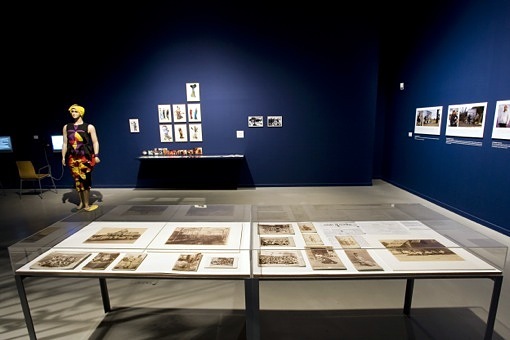La Casa Encendida ,
Jun 05, 2014 - Jul 12, 2014
Madrid, Spain
"A Critique of Migrant Reason" (or of national-catholicism as a concentration-camp ideology)
by Jaime Vindel
Following this shocking introduction, the exhibition delves into the places that provide spaces for socialization with the affective surroundings of origin (as is the case with Magdalena Correa’s 2006 video of the phone-call shops of Barcelona’s Raval neighborhood), the cartographic corporality of immigrants’ countries of origin, and the bloody demarcation line drawn by the Melilla wall, imposed on sub-Saharan immigrants’ desire to reach Europe (as in Miguel Benlloch’s performance, AcuCHILLAd+s, 2014). In both cases, the voices and images lose a certain intensity in view of a literalness that, despite its good intentions, is rather more crafty in Benlloch’s performance, when contrasted with the sharpness of the registers that have come to light in recent months regarding the injuries sustained by people trying to jump over the very same wall.
That has not been the only damage sustained in recent months by immigrants seeking to enter the few remaining vestiges of Spanish colonies on the African coast. This past 6th of February, fifteen people drowned on Ceuta’s Tarajal beach. The immigrants were shot using rubber pellets by members of Spain’s Guardia Civil –who never sought to help them, nor did they alert the coastguard— as they tried to reach the shore. Although the Ministry of the Interior initially denied the incident, in the end it was forced to admit it had taken place following the appearance of a series of videos showing what had happened. The official policy thus provided new shades of meaning to the content of Rogelio López Cuenca’s piece, Picasso opening (2013), in which he contrasted the spectacular conversion of the modernist icon with the journalistic normalization of the "drama" of immigration. The statement "Due to copyright reasons the image is not available" established the way in which the reproduction of property rights as well as the toning down of the suffering of others acts as the structural underpinning of political and social sensitivity. In that regard the curators very appropriately designed the layout of the exhibition to complement a broader view of colonial/modern reason by pointing out the singular manner in which it has been incorporated into the cultural hegemony of the contemporary Spanish State.
That is where the final part of the show gains importance. The grotesque nature of Lucía Egaña’s sleight of hand is in fact an excuse for a bitingly sarcastic take on national-catholicist stereotypes. The display cabinet that shows the work brings together several items that have helped to shape that imaginary, such as a copy of the Historia ilustrada de la Guerra Civil española (Illustrated History of the Spanish Civil War, 1970), signed by the pro-Franco author and columnist of the El Alcázar newspaper[5],Ricardo de la Cierva. That questioning of the stability and predominance of the iconography of things Hispanic is further examined in an installation that revisits, in an exhibition format, Daniela Ortiz and Xose Quiroga’s "Via Crucis", Homenaje a los caídos,(Tribute to the Fallen, 2012). Timed to coincide with Hispanic Day, on October 12th they created a performance that provided food for thought on the historical revision of national-catholicist reason. It took the form of the concentration-camp policies to which immigrants are subjected in Alien Detention Camps (CIEs). Given that, as we have pointed out, the idea of race is consubstantial to contemporary Eurocentrism’s definition of otherness (it is no coincidence that Hispanic Day was known -- and still is-- both in Franco’s time and in many now independent Latin American countries as the "Day of the Race"), preceding even discrimination on the basis of skin color, it is not mere happenstance that that discriminatory otherness should be reappearing in all its historic intensity at a time when the Spanish State is experiencing an economic, social and political crisis. Ortiz listed all those factors as informing her procession through Madrid’s urban geography, which took her from the Plaza de Colón (Columbus Square), whose Discovery gardens are the backdrop for the Spanish army’s annual parade, to the Hospital 12 de Octubre, to which Samba Martine, a citizen of the Democratic Republic of Congo was transferred after repeatedly being denied medical attention during her detention at the Carabanchel CIE. Martine’s face appears on the banner carried by Ortiz throughout her parade, which also included the streets of Madrid’s Aluche district, subsequently ending at the Carabanchel CIE. The Carabanchel Alien Detention Camp is located near Carabanchel prison, which closed in 1998. In that year the residents of the neighborhood demanded that the prison be turned into a Center for Historical Remembrance, since it had been a prison for Republican political prisoners in the Franco era, but the building was demolished in 2008.
|













